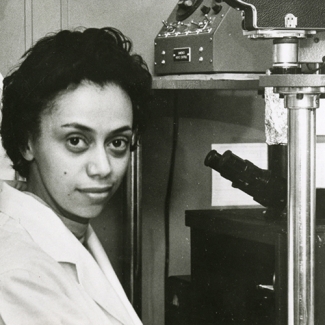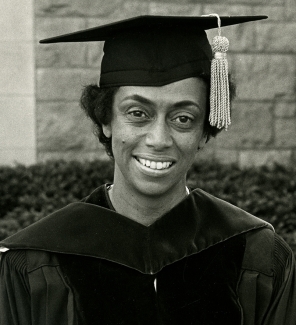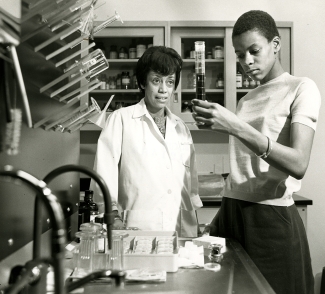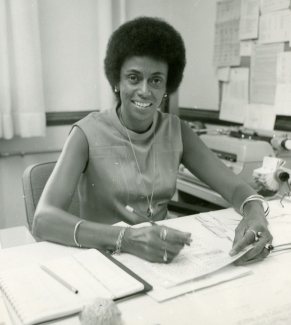Jewel Plummer Cobb
(1924-2017)
MBL Affiliation from 1949 to 2007 as an Investigator, Library Reader, and Corporation Member
As the civil and women’s rights movements gained great momentum in the 1960s, Jewel Plummer Cobb was deeply engaged in cancer research as a biology professor at Sarah Lawrence College in New York. Over the decade, Cobb had perfected methods for culturing patient cells in the lab so she could test the effects, both beneficial and harmful, of various agents on the cells. Cobb’s research was laying a strong foundation for understanding skin cancer and for developing chemotherapy for many types of cancers.
Yet Cobb heard the winds of change. In 1969, she accepted an offer to become dean and professor of zoology at Connecticut College. This meant long hours: She spent mornings in the lab continuing her research, and afternoons delving into leadership work at the college. But it also afforded Cobb a chance to nurture a growing mission: Find ways to increase the marginal number of women and minorities in science. “I moved into administration without any regrets,” she said. “At the time I felt I could make more changes and be more influential.”
Cobb went right to work, establishing a Black scholarship at Connecticut College and a post-baccalaureate program to prepare minorities for degree programs in medicine or dentistry. In 1974, Cobb became the first Black woman appointed to the National Science Board, which sets priorities for National Science Foundation (NSF) grants. She also helped form the first iteration of the NSF’s Committee on Women and Minorities in Science. Cobb chaired the first Conference for Minority Women Scientists in 1975, which produced a highly influential report and “blueprint for change” on the reasons for “our small numbers, relative invisibility, and exclusion from mainstream science.”
I’d like to be remembered as a Black woman scientist who cared very much about what happens to young folks, particularly women, going into science.
— Jewel Plummer Cobb
Cobb published her last scientific paper in 1976, the same year she became full-time dean of the women’s division at Rutgers University. Over the next decades, she wrote numerous reports on the underrepresentation of women and minorities in science, and wherever she went she instituted programs to address these inequities. Cobb was appointed president of California State University, Fullerton in 1981, the first Black woman to lead a college west of the Mississippi.
Only the “superior scholar, independent and tenacious, and somewhat hardened by her experience on her way through ‘the system’” survives in science, Cobb wrote in an influential article, “Filters for Women in Science,” in 1979. At the time, only 10 percent of scientists and engineers in the country were women. In illuminating the successive “filters” that females (and not males) encounter that winnow them out of science, some of the reasons for Cobb’s own extraordinary success emerge.
A Promising Beginning
Jewel Plummer was born in 1924 in Chicago. Her father, Frank, was the first Black person to receive an M.D. degree from Cornell University and her mother, Carriebel, a college graduate, was a physical education and dance teacher. From a young age, Jewel’s parents encouraged intellectual exploration, including her father’s scientific library. Thus, Jewel avoided the earliest “filters” that girls of her age encountered: pervasive socialization that they would become mothers and homemakers only; and the idea that math is a “male” subject. “Fundamental to encouraging more women to consider careers in the sciences is eradication of the notion that proficiency in mathematics is a gender-linked characteristic,” Cobb wrote.
Cobb originally planned to pursue physical education but fell in love with biology as a sophomore in high school. “It was the first time I ever used a microscope, and I found that wonderful to be able to see things through it that I could not see ordinarily. That was fascinating,” she said. An excellent student, Cobb gained admission in 1942 to the University of Michigan, a major research university that had more than 200 Black students enrolled, which was unusual diversity at the time.
However, at UMichigan Cobb encountered housing segregated by race and rampant social exclusion; the experience was a “disaster for Black students,” she said. After three semesters she transferred to Talladega College, a historically Black college in Alabama. There, she found important mentors, including bacteriology professor James R. Hayden, thereby passing through another filter.
In contrast to her own experience, Cobb later wrote, college advisors often fail to encourage female students to major in science, partly because they know women will have fewer job opportunities in the profession and will earn less. “The sciences and engineering are considered male territories, and as such do not present congenial environments for female students, who are always in the minority, except at women’s colleges,” she wrote. One possible solution, she wrote, is to provide female freshmen at universities with role models by sending teams of women scientists and postdocs to mentor them for a few days.
Cancer Research
Cobb pursued graduate studies at New York University, where she was mentored by M.J. Kopac and earned her Ph.D. in cell physiology in 1950. Her doctoral research formed the basis for her lifelong interest in melanin (a pigment found in skin, hair, and other tissues) and skin cancer. For her dissertation, Cobb characterized tyrosinase, an enzyme required for melanin synthesis, and tested its use for producing melanin in the lab. Later in her career, Cobb showed that deeper melanin pigmentation protects skin cells from X-ray treatment, providing the first evidence for melanin’s ability to protect cells from damaging UV radiation. It is now known that people with light skin have higher rates of skin cancer than those with darker skin pigmentation.
While a graduate student, Cobb spent the summer of 1949 as an independent investigator at the Marine Biological Laboratory (MBL), where she studied the inhibition of cell division in sea urchin (Arbacia) eggs. This was an early foray into a research interest Cobb would develop extensively in later years: how hormones, ultraviolet light and chemotherapeutic drugs can cause changes in cell division.
Upon graduation, Cobb received and accepted three prestigious postdoctoral research offers: One at Columbia University, one with the National Cancer Institute, and, most importantly, one at the National Cancer Institute at Harlem Hospital. At the latter, she worked under Louis Tompkins Wright, the first Black graduate of Harvard Medical School, and established an important research collaboration with his daughter, oncologist Jane C. Wright. Cobb became particularly skilled during this fellowship in human tissue culture, especially culturing cancer cells taken from patient tumor biopsies.
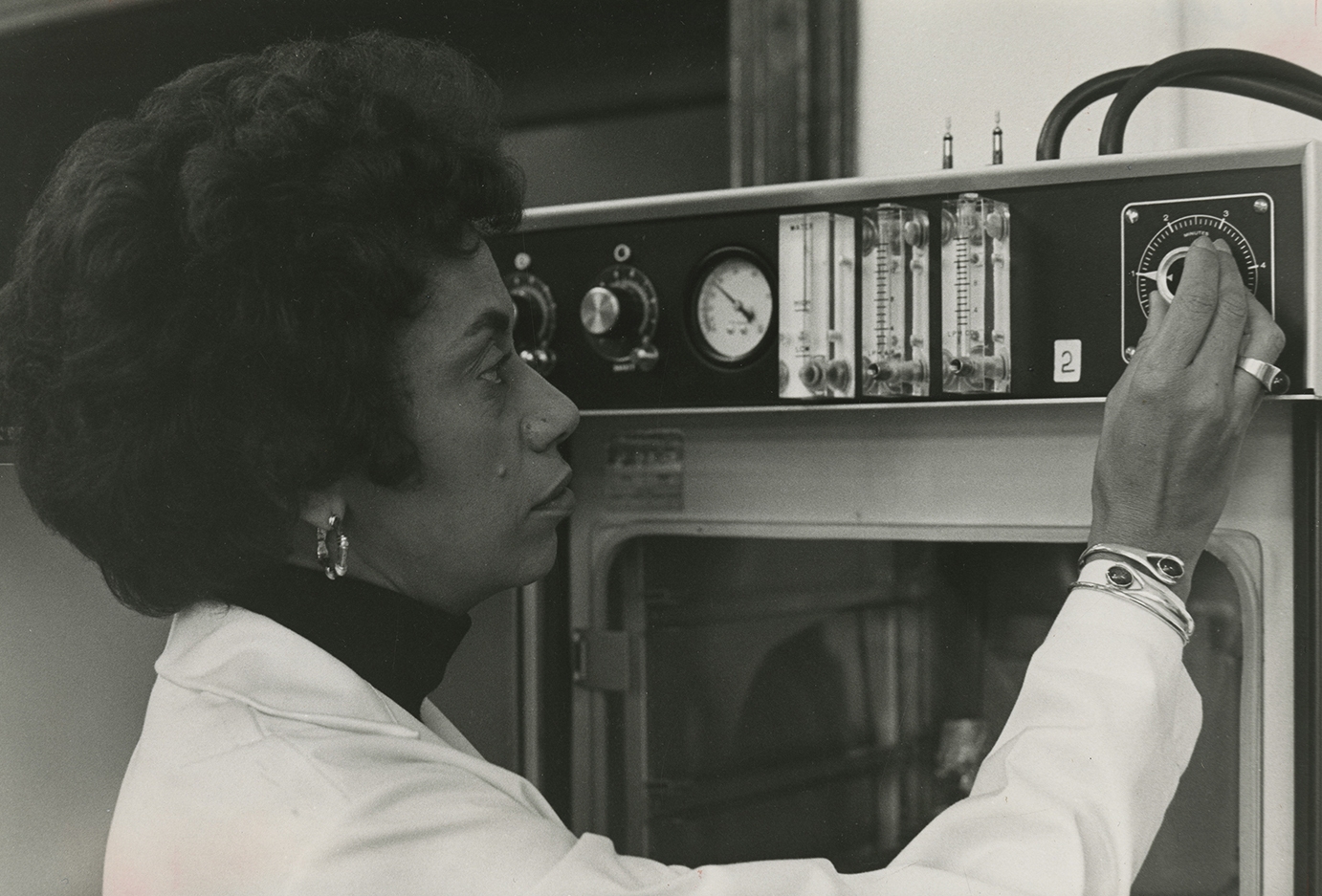
In 1952 Cobb founded her own laboratory at the University of Illinois Medical School, where she established the school’s first tissue culture facility. Two years later, she moved her lab back to Harlem Hospital, where she resumed her innovative collaboration with Jane Wright. Wright was studying the effects of chemotherapy in cancer patients, and in parallel, Cobb cultured cells from the tumors of these patients and studied their response to chemotherapy treatment.
“These experiments were some of the earliest forms of translational medicine, as both Cobb and Wright realized that the in vitro results might be used to predict beneficial treatments for specific patients and cancer sub-types,” writes Ellen Elliott of this work.
Cobb and Wright made a critical contribution in the early 1960s by demonstrating the effectiveness of methotrexate in treating skin and lung cancer, as well as childhood leukemia. Methotrexate is now used for a broad range of cancers, including breast cancer.
A Woods Hole Legacy
Cobb’s first summer at MBL led to a deep connection with Woods Hole, where she eventually bought a second home. She became a MBL Corporation member in 1972 and was a named an emeritus member of the MBL Society in 2007. Cobb was a Library Reader for many years, and also served on the MBL Campaign Steering Committee from 1997 to 2000.
Plummer married Roy Cobb, an insurance salesman, in 1954 and they had a son, Jonathan. They divorced in 1967. Cobb retired from the presidency of California State University, Fullerton in 1990 and died in 2017.
Cobb’s distinguished contributions to scientific research, education, and inclusiveness did not go unrecognized. She was elected to the National Institute of Medicine in 1974 and received a Lifetime Achievement Award for Contributions to the Advancement of Women and Underrepresented Minorities from the National Academy of Sciences. She was the recipient of 21 honorary doctorates and was a trustee of several universities and corporations.
In 2020, Agassiz Road in Woods Hole was renamed Jewel Cobb Road, in honor of an outstanding scientist and advocate for women and minorities in science.
—By Diana Kenney
References:
Cobb, Jewel Plummer (1979) Filters for Women in Science. Annals of the N.Y. Academy of Sciences, DOI: 10.1111/j.1749-6632.1979.tb16857.x
Crowley, Jack (2020) Jewel Plummer Cobb’s Trail-Blazing Life and Legacy of Representation in Academic Science (video).
Elliot, Ellen (2018) Women in Science: Jewel Plummer Cobb (1924-2017). The Jackson Laboratory blog.
Jewel Plummer Cobb (memorial notice, Marine Biological Laboratory)
Jewel Plummer Cobb, Woods Hole Historical Museum
Jewel Plummer Cobb Collection, Online Archive of California.
Jewel Plummer Cobb Leaves a Legacy of Leadership (memorial notice, California State University, Fullerton)
Malcolm, Shirley Mahaley, Paula Quick Hall, and Janet Welsh Brown (1975) “The Double Bind: The Price of Being a Minority Women in Science,” report on the first Conference for Minority Women Scientists, chaired by Jewel Plummer Cobb for the American Association for the Advancement of Science (AAAS).
The Collecting Net, Vol. XIX, No. 1, Nov. 1949: https://hdl.handle.net/1912/22039
Jewel Plummer Cobb’s Scientific Publications:
Antikajian G, Wright LT, Plummer JI, Weintraub S.J The effect of triethylene melamine, aureomycin, and some 4-amino derivatives of folic acid on tissues in vitro. J. Natl Cancer Inst. 1951 Oct;12(2):269-74.
Plummer JI, Wright LT, Antikajian G, Weintraub S. Triethylene melamine in vitro studies. I. Mitotic alterations produced in chick fibroblast tissue cultures. Cancer Res. 1952 Nov;12(11):796-800.
Wright JC, Foster P, Billow B, Gumport SL, Cobb JP. The effect of triethylenethiophosphoramide on fifty patients with incurable neoplastic diseases. Cancer. 1957 Mar-Apr;10(2):239-45.
Cobb, Jewel Plummer, and Dorothy G. Walker. Effect of Actinomycin D on Tissue Cultures of Normal and Neoplastic Cells23. 1958, J. Natl Cancer Institute.
Cobb JP, Wright JC. Studies on a craniopharyngioma in tissue culture. I. Growth characteristics and alterations produced following exposure to two radiomimetic agents. Neuropathol Exp Neurol. 1959 Oct;18:563-8.
Cobb JP, Walker DG, Wright JC. Observations on the action of triethylene thiophosphoramide within individual cells. Acta Unio Int Contra Cancrum. 1960;16:567-83.
Cobb, JP, and Walker DG. Studies on Human Melanoma Cells in Tissue Culture I. Growth Characteristics and Cytology. Cancer Research 20.6 (1960): 858-867.
Cobb, JP, DG Walker, and JC Wright. Comparative chemotherapy studies on primary short-term cultures of human normal, benign, and malignant tumor tissues—a five-year study. Cancer Research 21.5 (1961): 583-90.
Wright, JC, Cobb, JP,Gumport, S, Safadi, D, Walker, DG .Further investigation of the relation between the clinical and tissue culture response to chemotherapeutic agents on human cancer. Cancer, 1962
J P Cobb, D G Walker Cytologic studies on human melanoma cells in tissue culture after exposure to five chemotherapeutic agents. Cancer Chemother Rep 1968 Sep;52(5):543-52.
Cobb JP, McGrath A.J S91 mouse melanoma sublines following total in vitro versus alternate in vivo passages. J. Natl Cancer Inst. 1972 Apr;48(4):885-91.
Cobb JP, McGrath A, Willetts N. Response of Cloudman S91 melanoma cells to melanocytestimulating hormone: enhancement by cytochalasin B. J Natl Cancer Inst. 1976 May;56(5):1079-81. doi: 10.1093/jnci/56.5.1079.
